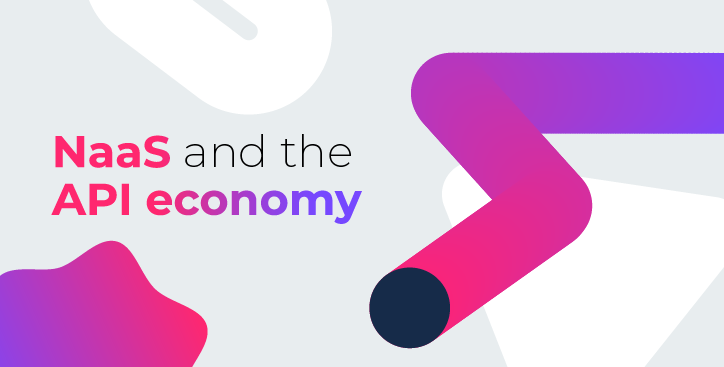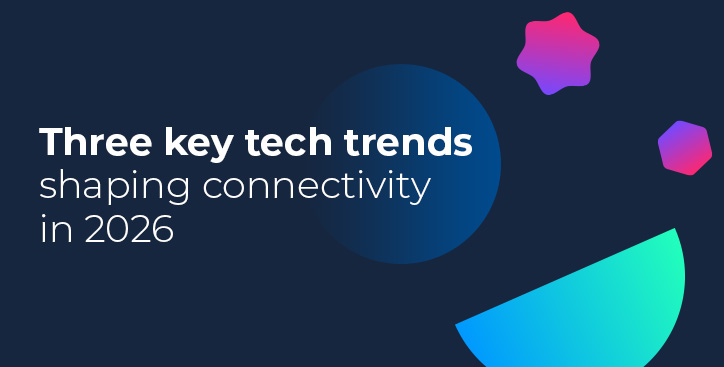NaaS and the API economy
By Alex Hawkes|29 August, 2023

In our previous blog, we looked at the rise of the API economy. In this instalment we explore how APIs are transforming the provisioning of connectivity through the move to Network-as-a-Service (NaaS).
APIs in the cloud connectivity ecosystem
It should come as no surprise that APIs have become crucial to the world of connectivity. There is a famous anecdote about Jeff Lawson, co-founder and CEO of communications platform Twilio, when seeking investment in 2008. Lawson was able to demonstrate to investors that Twilio had condensed the complex and messy world of telephony down to five API calls. And that was all the investors needed to see.
What Twilio had achieved was a way to navigate the complex spider’s web of telephony providers using the API ecosystem to broker and negotiate connections to get a call or message from A to B.
Today trade associations such as the GSMA are pushing initiatives such as the Open Gateway - a framework of common network APIs designed to provide developers with universal access to operator networks, with the aim of deploying services more quickly across via single points of access to the world’s largest connectivity platform.
Another effort is the MEF’s LSO Sonata API standardisation initiative being conducted within the context of the MEF 3.0 Global Services Framework, intended to standardise multiple sets of APIs enabling service automation across multiple providers and over multiple technologies.
In the case of communications networks, APIs exist to help ensure that connectivity between different assets remains strong enough to enable efficient collaboration even as workflows and processes are changing.
Using APIs for network integration
For Network-as-a-Service (NaaS) providers like Console Connect, APIs play a crucial role in interconnecting partner ecosystems and the standardisation of APIs is critical for bringing down the barriers for automated interconnection between networks by developing a common language for developers and engineers to make calls across different providers.
Console Connect is actively using API standards in product development. For example, in April 2023, we launched Edge Port , a solution which provides a dedicated connection to the Console Connect platform and network directly from an office location, enabling access to fast, reliable and agile connectivity to accelerate digital transformation.
Edge Port leverages MEF LSO Sonata APIs to automate the pre-order and order processes for last-mile services. In the backend, the Console Connect platform is tightly integrated with APIs, enabling quoting and ordering with many vendors worldwide, enabling our customers to see real-time pricing for last-mile services to their enterprise building.
APIs have also been leveraged to orchestrate connectivity and increase interoperability between networks.
In 2022, Console Connect completed the first stage of an API-led integration between the Console Connect and Colt on-demand platforms. By integrating these two SDI platforms via a customised API, the providers were able to create seamless quoting, ordering and provisioning of on-demand services between two high-performance networks in real-time.
Benefits of API driven networking for businesses
With mission-critical workloads moving to the cloud and every CIO in the world seeking increased agility and improved application performance, companies are finding that for connecting cloud apps to an office environment or to other applications outside the firewall, the public internet is insecure and unreliable.
This is where private or dedicated links between assets are becoming popular. But typically, a company will pay for the time the dedicated link is active, as well as for data transferred out of the cloud. Understandably, companies don't want to leave this access open all the time. Such elasticity on demand is one of the key benefits of a NaaS solution, but still requires manual intervention.
Here we have one of the key use cases of an API-driven Software Defined Cloud Interconnect (SDCI) fabric enabling NaaS.
Paul Gampe, CTO of Console Connect, explains; “As an enterprise, I can hit a Console Connect endpoint in my backup script and action an increase in my connectivity to the cloud from 50Mbps to 500Mbps. The backup script operates and then at the conclusion of the backup it hits that API endpoint again and brings the connectivity bandwidth back down from 500Mbps to 50Mbps. So because Console Connect has API endpoints available, customers are able to do that orchestration for which there's an economic incentive to do so.”
Console Connect is creating an API ecosystem that is abstracting the rate of change that happens in these cloud provider API endpoints and providing a consistent experience, a stable API endpoint for the enterprise, and as much as possible trying to unify that experience.
So regardless of whether an organisation is doing a backup into Microsoft Azure or a backup into Alibaba Cloud it's basically the same API endpoints they see on Console Connect, even though there are wildly different workflows and API endpoints that need to be implemented into the Console Connect fabric itself.
In much the same way that there is a big emphasis on business APIs to unlock data and capabilities in a reusable way, with many companies looking to run their APIs in the cloud and in the data centre, SDCI-fabrics like Console Connect are looking to do the same thing to connectivity.
By using connectivity APIs to provide resilient, reliable access to those business APIs deeper in the stack, Console Connect is capitalising on elasticity to better cope with spikes in demand and make efficient connections for customers, enabling them to adapt and innovate faster than the competition.



.jpg)





.jpg)